Locating Edgefield District
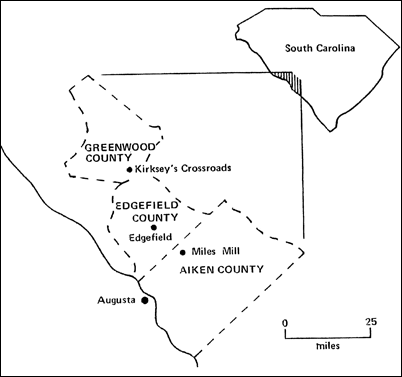 Fig. 1. The old Edgefield District, South Carolina, showing division into later counties. Adapted from John M. Vlach, The Afro-American Tradition in Decorative Arts.
Fig. 1. The old Edgefield District, South Carolina, showing division into later counties. Adapted from John M. Vlach, The Afro-American Tradition in Decorative Arts.
The old Edgefield District encompassed today’s Edgefield, Aiken, and Greenwood counties in west-central South Carolina, across the Savannah River from Augusta, Georgia. The district lay on the Fall Line (an imaginary line that separates the Piedmont Plateau from the Coastal Plain), a source of large deposits of alluvial stoneware clay.1 The district is notable historically as the home of ten of South Carolina’s governors, including Populist firebrand “Pitchfork” Ben Tillman and Strom Thurmond, who went on to become a United States Senator; for its reputation for violence, including duels, murders, and racial intimidation by a Klan-like group known as the Red Shirts to discourage African Americans from voting during Reconstruction; and as a jumping-off place for westward settlement, starting with Georgia’s interior, in the late eighteenth and early nineteenth centuries (Burton 1985)
Early Pottery History
More apropos to this essay, Edgefield District is important in American ceramics history as the birthplace of the alkaline glazes that became the norm on stoneware through much of the lower South, and for its large concentration of African Americans engaged in the potter’s craft. An 1817 map of the district shows the two pioneering sites: Dr. Abner Landrum’s Pottersville Stoneware Manufactory just northeast of Edgefield town and that of his brother, the Reverend John Landrum, on Horse Creek to the south (Horne 1990, 19; Burrison 1983, 113; Todd 2008: front matter; Koverman 1998, 9). Abner was a physician, scientific farmer, land speculator, and newspaper publisher as well as stoneware manufacturer. As an indication of his familiarity with world ceramics, he named three sons after great names in European ceramics—Wedgwood, Palissy, and Manises.2 His other brother, Amos, also was a potter, and there are hints that their father, Samuel, was too; Samuel’s family was associated with known potters back in North Carolina before he settled in Edgefield District in the late 1700s (Baldwin1993, 30).
 Fig. 2. Silhouette of Edgefield stoneware pioneer Dr. Abner Landrum. Courtesy of McKissick Museum, University of South Carolina.
Fig. 2. Silhouette of Edgefield stoneware pioneer Dr. Abner Landrum. Courtesy of McKissick Museum, University of South Carolina.
The two Landrum workshops, which opened in about 1815, produced stoneware vessels primarily for storing food and drink. The earliest dated Edgefield pieces were made in those shops: a straight-sided, tall-necked bottle signed by Abner Landrum and dated 1820 (Hewitt and Sweezy 2005, 106–7), and a jar and jug, both of two-gallon capacity and dated 1821. All are covered in a lime-based alkaline glaze (explained later in this essay). The jar, with its wide mouth and horizontal lug (slab) handles (Horne, 50), could have been used for preserving solid food, such as vegetables or meat; the jug, with its narrow neck and vertical loop handle (Baldwin 1993, 40; Burrison 2006, 102 [top]; Todd 2008: color plate 3; Koverman 26 [left]; Horne 1990, 108 [bottom] and 109 [right]), would have kept such liquids as whiskey, cane syrup, or vinegar. The latter vessel has a detail that remained characteristic of some Edgefield jugs through the 1860s as well as of those by Edgefield-trained potters who migrated westward: a double-collared neck, with a ring turned in the neck’s middle and the lip widened as a second collar, probably to facilitate the tying down of a stopper as well as a local design feature.
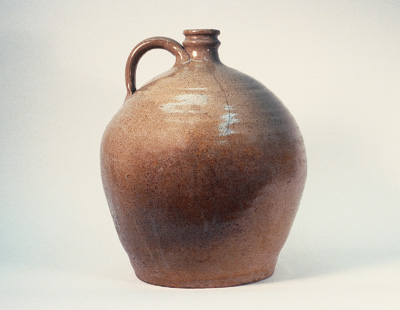 Fig. 3. Jug attributed to Abner Landrum’s Pottersville Stoneware Manufactory, dated 1821; note double-collared neck. H. 14 inches. Private collection; courtesy of McKissick Museum, University of South Carolina.
Fig. 3. Jug attributed to Abner Landrum’s Pottersville Stoneware Manufactory, dated 1821; note double-collared neck. H. 14 inches. Private collection; courtesy of McKissick Museum, University of South Carolina.
International Connections
Many of Edgefield’s ceramic forms have European, especially British, roots. For example, the district’s lug-handled jars bear a strong resemblance to those of Scotland and northern England (Burrison 2007, 94).3 The generic American jug form harks back to both Britain and Germany, with larger, two-handled examples (known as syrup jugs in the South) strongly resembling those of northern England (Burrison 2006, 106–7).
A second international influence on Edgefield stoneware may have been Africa. Perhaps the most striking local products were jugs and other vessel forms with applied faces made by both African American and white potters; possible African sources for them will be considered later in this essay. A type of water jug for quenching thirst in the fields, known by the Afro-Caribbean name “monkey jug” and having a stirrup-shaped handle across the top and two angled spouts on either side of the handle, was unknown in Britain but was common in Mediterranean Europe and Africa, the latter being the most likely source of the form in the South (Burrison 2006, 109–10). Sculpted faces sometimes were applied to this form by Edgefield potters.
The most surprising international influence on the Edgefield tradition involves the alkaline stoneware glazes (still used by some southern folk potters), which turn either green or brown when fired. They contain wood-ashes or lime as a flux to help melt the sand and clay that are the other key ingredients and are prepared as a solution into which the pots are dipped before firing, unlike the salt glaze used on stoneware further north and introduced to colonial America from Germany and England.4 High-firing alkaline glazes arose in China during the Han dynasty (206 BCE–220 CE) and continue to be used in the Far East today. In the early 1700s Père D’Entrecolles, a French Jesuit missionary stationed in China, wrote letters describing stoneware and porcelain production in the town of Jingdezhen, including detailed recipes for ash-and lime-based glazes. His letters were published in 1736 in Jean-Baptiste du Halde’s General History of China, which became a standard reference on that country. I believe those glaze recipes were read by Abner Landrum about 1810, probably coinciding with his discovery of good Fall Line stoneware clay, and he saw their readily available ingredients as a practical substitute for the salt that was a scarce commodity in the back-country (Burrison 2007, 60–61, 191 [note 50]).5
Slip Decoration
Another Edgefield ceramic innovation didn’t spread beyond its origins as did the alkaline glazes and had a much briefer life span, only about fifteen years. This was the technique of slip decoration, in which liquid clay of contrasting color is trailed or brushed onto a pot’s surface before glazing and firing. This combination of slip decoration and alkaline-glazed stoneware is unique in American ceramics to antebellum Edgefield District. However, such decoration was widespread on lead-glazed earthenware in Europe and the United States,6 and was likely adopted by Edgefield’s pottery entrepreneurs to create a visually appealing product that would give them a competitive advantage.
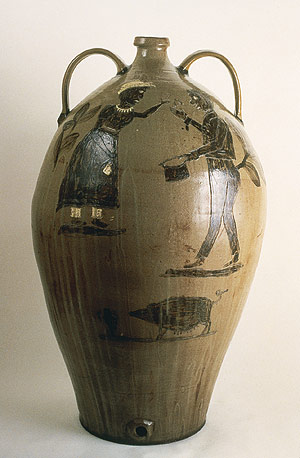 Fig. 4. Water cooler depicting what seems to be a slave wedding in two colors of slip, stamped “PHOENIX / FACTORY / ED.SC,” ca. 1840. H. 31.25 inches. Collection of High Museum of Art, Atlanta; purchase in honor of Audrey Shilt, President of Members Guild, 1996–1997, with funds from Decorative Arts Endowment and Decorative Arts Acquisition Trust.
Fig. 4. Water cooler depicting what seems to be a slave wedding in two colors of slip, stamped “PHOENIX / FACTORY / ED.SC,” ca. 1840. H. 31.25 inches. Collection of High Museum of Art, Atlanta; purchase in honor of Audrey Shilt, President of Members Guild, 1996–1997, with funds from Decorative Arts Endowment and Decorative Arts Acquisition Trust.
The first Edgefield workshop to apply slip decoration was the short-lived Phoenix Factory, established in 1840 by Collin Rhodes and Robert Mathis, former owners of the Pottersville Stoneware Manufactory after Abner Landrum left that operation. Dark brown, iron-rich slip, as well as white slip made from local kaolin, were used, sometimes in combination (Horne 1990, 58–59, 64, 124; Baldwin 1993, 149–51). Rhodes and Mathis employed highly skilled potters such as Thomas Chandler, one of the finest potters ever to work in the South. Chandler was born in Virginia in 1810 into what may have been a family of potters of English descent. In the late 1830s he came to Edgefield District where he first worked at the Phoenix Factory. He then moved to Kirksey’s Crossroads in the northern part of the district, establishing his own workshop there in 1850 where he and his eleven workers produced graceful forms with celadon-like alkaline glazes over tasteful looping or floral designs in slip.
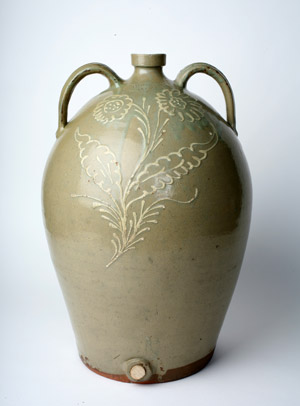 Fig. 5. Water cooler stamped “CHANDLER / MAKER” with kaolin-slip floral decoration, dated 1851. H. 20.5 inches. Private collection; photo by David Greear, courtesy of Folk Pottery Museum of Northeast Georgia.
Fig. 5. Water cooler stamped “CHANDLER / MAKER” with kaolin-slip floral decoration, dated 1851. H. 20.5 inches. Private collection; photo by David Greear, courtesy of Folk Pottery Museum of Northeast Georgia.
Chandler’s main competition in the slip-decorated stoneware line was Collin Rhodes, a native South Carolinian who married into the Landrum family and established his own plantation workshop after leaving his Phoenix Factory partnership. Jugs, sometimes signed in slip, were his specialty. He may not have been a potter himself; in 1850 he owned thirty-five slaves, some of whom undoubtedly were employed at pottery-making. Rhodes’s shop produced wares for merchants throughout South Carolina, their names inscribed in slip as advertisements. Slip also was used there to create designs less formal than Chandler’s, including hoop-skirted southern belles in two colors.
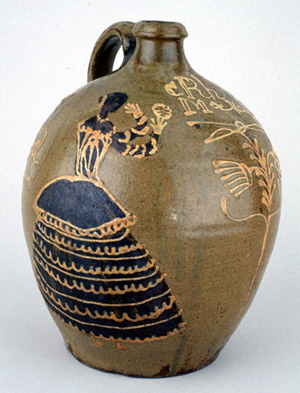 Fig. 6. Jug signed “C Rhodes / Maker” depicting hoop-skirted belle in two colors of slip, ca. 1850. H. 13.25 inches. Collection of Abby Aldrich Rockefeller Folk Art Museum, Colonial Williamsburg Foundation, Williamsburg, Virginia.
Fig. 6. Jug signed “C Rhodes / Maker” depicting hoop-skirted belle in two colors of slip, ca. 1850. H. 13.25 inches. Collection of Abby Aldrich Rockefeller Folk Art Museum, Colonial Williamsburg Foundation, Williamsburg, Virginia.
David Drake, Slave Potter-Poet
Edgefield’s most intriguing potter, and the only enslaved African American potter about whom much is known (Todd 2008), was David Drake, known simply as Dave until Emancipation. Dave was remarkable in several respects: under a later master, Lewis Miles, he was allowed to sign his creations (along with Miles’s initials), a privilege otherwise unheard of for slave artisans; he seems to have anticipated his legacy to later researchers by dating many of his pots; about thirty of his surviving jars have short poems of his own composition incised in the damp clay, making him the only potter in the antebellum South to verbally enhance his wares; and he made some of the largest pots in American ceramics history.
Dave was “country born” (i.e., born in the United States rather than Africa) in 1801. His first known owner was Harvey Drake, Abner Landrum’s nephew and partner in the Pottersville Stoneware Manufactory. Drake subscribed to the liberal Christian view that it was his duty to teach his servants to read the word of God, and it’s likely that he was the one who taught literacy to Dave, who furthered that gift while helping at Abner Landrum’s newspaper, the Edgefield Hive. Of the five owners under whom Dave worked, he chose the first, Drake, as his surname following Emancipation.
In 1834, a few months after Dave inscribed his first known pot-poem, the South Carolina General Assembly passed a harsh law making it illegal to teach slaves to read and write. Dave would have acquired that skill perhaps a decade earlier, in the 1820s, at the same time he was learning the potter’s craft, probably also from Harvey Drake. Drake died in 1832, but Dave kept working at Pottersville under Harvey’s brother, Reuben, then moved to Horse Creek under Abner Landrum’s brother John, finally passing in 1840 to John Landrum’s son-in-law, Lewis Miles, under whom Dave flourished as a poetic potter at Miles’s Stony Bluff plantation where he was given the limited freedom to sign his work.
The subjects of Dave’s poems vary widely.7 Inscribed on a twenty-five-gallon, four-handled jar dated 1858 (now in the Folklife Gallery of the Atlanta History Museum) is this: “A very large Jar = which has 4 handles = / pack it full of fresh meats – then light = candles –” (Burrison 1983, 21; Todd 2008, 202; Koverman 1998, 62). Like the pot-poetry on some English and Pennsylvania-German earthenware (Koverman 1998, 63–70), this verse describes the jar’s function, the candles perhaps a reference to sealing butchered meat with melted wax or tallow. One of Dave’s earliest dated but unsigned pots, made at Pottersville in 1836, displays his longest poem, a quatrain:
horses mules and hogs – / all our cows is in the bogs – / there they shall ever stay / till the buzzards take them away. (Koverman 1998, 28 [bottom])
It was made a few weeks after many of his enslaved companions were taken by Reuben Drake to Louisiana. Left behind, Dave may have felt himself “in the bogs.” This was about a year after Dave had lost a leg in an accident.
One of Dave’s largest jars, nearly three feet tall with a capacity of about forty gallons, was made at Lewis Miles’s Stony Bluff Manufactory in 1859 and signed in Dave’s handwriting, “Dave & Baddler.” With only one leg, Dave must have needed the help of fellow-slave Baddler to turn the foot-powered potter’s wheel. It would have taken a large kiln to fire pieces of this size, and the Stony Bluff kiln was indeed enormous: about eighty feet long. The poem on this monumental jar, now in the Charleston Museum, reads, “Made at stoney bluff, / for making or adgin [aging?] enuff” (Todd 2008, 214; Baldwin 1993, 43 [second line misread in caption]). A companion nearly as large, dated the same day, signed the same way, and in the same collection, reads, “Great & Noble jar / hold Sheep goat or bear” (Baldwin 1993, 78 [upper right] and color plate 1; Vlach 1990, 79–80; Todd 2008, 114).
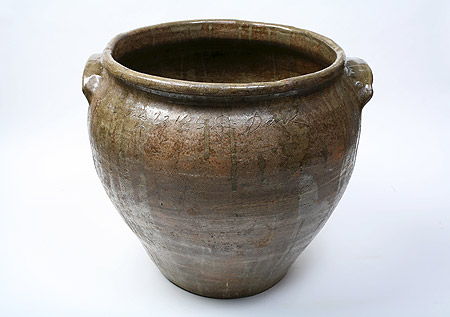 Fig. 7. Food-storage jar signed “Dave” (David Drake) with his “sun moon and stars” poem, dated July 29, 1858. H: 20.25 inches. Private collection, photo by David Greear. Courtesy of the Folk Pottery Museum of Northeast Georgia.
Fig. 7. Food-storage jar signed “Dave” (David Drake) with his “sun moon and stars” poem, dated July 29, 1858. H: 20.25 inches. Private collection, photo by David Greear. Courtesy of the Folk Pottery Museum of Northeast Georgia.
Some of Dave’s poems are unclear in meaning, at least to readers of today. A twenty-five-gallon jar dated 1858 carries this message: “the sun moon and – stars = / in the west are a–plenty of – bears.” Was this a reference to the constellations Ursa Major and Minor, the Big and Little Dipper? The former, supposedly known to slaves as the Drinking Gourd, points to Polaris, the North Star, and the folk song, “Follow the Drinking Gourd,” is thought to have been a coded instruction for escaped slaves fleeing to the North on the Underground Railroad.8 In that light, Dave’s poem could be interpreted as a veiled vision of escape. Another ambiguous rhyme, on a thirty-gallon jar dated July 4, 1859 and on display in the Folklife Gallery of the Atlanta History Museum, reads,
the fourth of July – is Surely come – / to blow the fife = and beat the drum //. (Koverman 1998, 52; Todd 2008, 228 and front cover)
Leonard Todd, in his book about Dave, concludes that “his words were meant only to mark an enjoyable holiday” (Todd 2008, 247). Consider, though, that Dave didn’t have the freedom to enjoy the holiday; he was working on that day, making this jar. Perhaps his poem was akin in intention to Frederick Douglass’s 1852 speech and essay, “What to the Slave is the Fourth of July?” (Douglass).
A few of Dave’s verses have romantic subjects. The poem on an 1857 jar reads, “a pretty little Girl, on a virge / Volca[n]ic mountain, how they burge” (Koverman 1998, 21; Todd 2008, 130), perhaps a description of someone Dave knew on the verge of blossoming into womanhood. A similar verse dated 1840 reads, “another trick is worst than this + / Dearest miss: spare me a Kiss +” (Koverman 1998, 34). Religion is yet another topic of Dave’s poetry. “I Saw a leopard, & a lions face = / then I felt, the need of Grace =” is a frightening vision perhaps inspired by beasts that herald the Day of Judgment in the biblical Book of Daniel (Koverman 1998, 82). That jar was made in 1860, when the Great Fear following John Brown’s 1859 raid on Harper’s Ferry had seized the South and there were rumblings of secession from the Union. Two years later, in the midst of the Civil War, Dave wrote his last known poem on a jar now in the Smithsonian Institution: “I, made this Jar, all of cross / If, you don’t repent, you will be, lost =” (Todd, next-to-last color plate; Hewitt and Sweezy 2005, 122–24).
A further subject of Dave’s poetry is money: “This noble Jar = will hold, 20 [gallons] / fill it with silver = then you’ll have plenty.” That 1858 jar may reflect Lewis Miles’s order for Dave to make a number of smaller jars for burying gold or silver in the uneasy times leading up to the Civil War. Other poems, such as “Give me silver or; either Gold = / though they are dangerous; to our Soul =” and “I made this Jar = for cash – / though its called = lucre Trash //,” suggest that Dave may have received some payment for his work, at least for commissioned pieces. One surviving jar clearly was commissioned; its non-poetic inscription in Dave’s handwriting reads, “Think of me when / far away Rosa D G Never / Mr Milton Miles / Edgefield.” Milton was the eldest son of Dave’s owner, Lewis Miles, and his message seems to be a salutation to neighbor and in-law Rosa D. Wever, with Dave serving as go-between.
A jar dated 1840, when ownership of Dave passed to Lewis Miles, leaves no question as to his slave status: “Dave belongs to Mr. Miles / wher [sic] the oven bakes & the pot biles ///” (Baldwin 1993, 76; Koverman 1998, 33; Vlach 1990, 81; Todd 2008, 93). His poem of 1857, “I wonder where is all my relation / friendship to all – and, every nation” (Koverman 1998, 38), is quite moving, probably a reflection on family members from whom he was separated at various times in his life. Nor were the kindnesses Dave received from others forgotten in his rhymes. Abner Landrum, who seems to have befriended Dave before moving to the state capitol, Columbia, to serve as State Printer and establish another pottery operation, died on April 3, 1859; news of this, or of his failing health, reached Edgefield by April 14, when Dave inscribed this on a fifteen-gallon jar: “Over noble Dr. Landrums head / May guardian angels visit his bed.”
The last known pieces Dave signed are dated 1864, during the height of the Civil War. The war’s end left Lewis Miles with financial difficulties. He leased his Stony Bluff pottery to three of his freedmen, and by 1867 he’d opened a new stoneware operation at Miles Mill along with his gristmill, sawmill, and tannery, consolidating his businesses to take advantage of the nearby rail line that was being built. Dave apparently went with him to Miles Mill, where he spent his last working days. The 1870 census lists him as David Drake, seventy-year-old black “turner” (a southern alternative, along with “jug maker,” for “potter”) in the same household as Mark Jones, also listed as a turner and evidently Dave’s son-in-law. Dave seems to have died in the late 1870s.
Face Vessels
Another African American contribution to the Edgefield stoneware tradition was face vessels such as those made by enslaved potters at the Palmetto Fire Brick Works in 1862–1865, some of the earliest examples of face jugs in the South (Burrison 2006, 110–15; Burrison 2007, 128–32; Vlach 1990, 81–93; Baldwin 1993, 79–87; Horne 1990, 29–36; Newell and Lenzo 2006; Koverman 2001). With their bared teeth and bulging eyes of kaolin inset into the darker stoneware clay (the contrast sometimes heightened by the addition of iron to darken the glaze and of wax to resist the glaze on eyes and teeth), they clearly were meant to represent the race of the makers, and strike me as nonverbal expressions of anger. Ceramics historian Edwin AtLee Barber was the first to write about them in the 1909 edition of his Pottery and Porcelain of the United States, based on correspondence with Thomas Davies, former owner of the Palmetto Fire Brick Works. With no mention of their meaning to the makers, Barber comments,
These curious objects . . . possess considerable interest as representing an art of the Southern negroes, uninfluenced by civilization, and we can readily believe that the modeling reveals a trace of aboriginal art as formerly practiced by the ancestors of the makers in the Dark Continent.
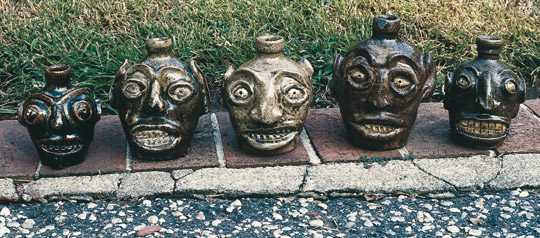 Fig. 8. Face jugs by slave potters at Thomas Davies’s Palmetto Fire Brick Works, Bath, South Carolina, 1862–1865. Private collection; photo by the author.
Fig. 8. Face jugs by slave potters at Thomas Davies’s Palmetto Fire Brick Works, Bath, South Carolina, 1862–1865. Private collection; photo by the author.
Was Barber’s assumption about African origins correct? There were indeed anthropomorphic ceramic traditions in West Africa where the American slave trade was concentrated. The Yungur people of Nigeria, for example, made portrait pots called wiiso to honor ancestral spirits at shrines. The problem is that African humanoid vessels seem to have been made later than those by South Carolina slaves, making it difficult to establish an African precedent. Even if African work in clay did not influence Edgefield face vessels, however, African work in wood, as carved ceremonial dance masks, may have. Such a shift in media could have been triggered in Edgefield District by a fresh infusion of 170 Africans from an illegal cargo on the slave ship Wanderer in 1858. One of them, named Romeo, evidently worked at Thomas Davies’ Palmetto Fire Brick Works in 1863.
Complicating the pursuit of origins for Edgefield and other southern face vessels is the universal impulse among clay-working societies to make containers in human likeness. For example, human-effigy pots were made by Native Americans of the Mississippian (Mound Building) period that ended in the 1500s. In England, this anthropomorphizing impulse emerged several times, first during Roman occupation, then in the Middle Ages, and finally, with the rise of Staffordshire’s pottery industry in the 1760s, as the Toby jug, a slip-cast character drinking mug. A German tradition of humanoid jugs is another possible influence on American face vessels. Known as Bartmannskruge, bellarmines, or graybeards, these salt-glazed stoneware jugs, made in the Rhineland from the sixteenth to eighteenth centuries, have a bearded mask molded on the neck. One of America’s first stoneware potters was John Remmey, who immigrated to Manhattan from the Rhineland in the 1730s. His descendants continued to make stoneware in New York and Philadelphia and were responsible for some of the earliest Euro-American face vessels, likely evolved from the German graybeard tradition.
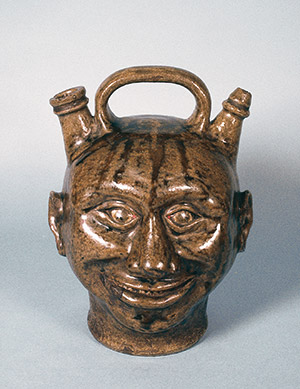 Fig. 9. Monkey-form face jug signed “CHANDLER / MAKER,” ca. 1850. H. 11 inches. Private collection; courtesy of McKissick Museum, University of South Carolina.
Fig. 9. Monkey-form face jug signed “CHANDLER / MAKER,” ca. 1850. H. 11 inches. Private collection; courtesy of McKissick Museum, University of South Carolina.
Returning to South Carolina, did white potters there make face vessels as early as the slave-made ones? The Remmey connection may be especially important when considering an ash-glazed, happy-face jug signed “CHANDLER / MAKER.” It was made about 1850, a decade earlier than the slave-made Palmetto Fire Brick Works examples. In 1830 Thomas Chandler had worked as a potter in New York State, where he may have picked up the face-jug idea from the Remmeys. In that case, speculative though it is, we could add Germany as an indirect international influence on Edgefield stoneware. Chandler’s face jug begs the question: did slave potters get the idea from him, or were they working in a separate, perhaps African-derived, tradition? We may never know.
Edgefield’s Decline and Influence
What we do know is that Edgefield District began to decline as a pottery center after the departure of key figures such as Chandler, who left for North Carolina in 1852, and Collin Rhodes, who moved to Louisiana in 1853. After the Civil War a few workshops such as that at Miles Mill did carry on (Baldwin 1993, chapter 4; Horne 1990, 77–84), with some freedmen working there and making face jugs. By 1900 stoneware production in Edgefield was virtually extinct, but the district’s influence elsewhere in the South was profound. The alkaline-glazed stoneware complex was carried westward—as far as Texas by the 1850s—by migrating potters trained in Edgefield (Baldwin 1993, 57–66; Horne 1990, 89–105; Burrison 1983, 44, 111–12, 123, 144, 189, 207, 214–15; Burrison 2010, 7, 13, 20–22, 137; Brackner 2006, 89–92, 298; Malone, Greer, and Simons 1979, 8–9; Brown 2002, 4–8), and is still being practiced by folk potters in Georgia and North Carolina.
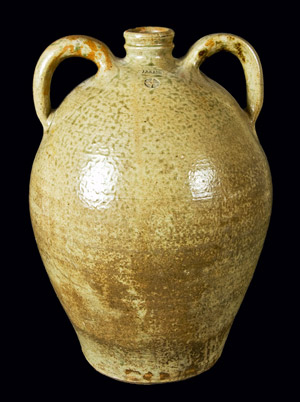 Fig. 10. Syrup jug by Edgefield-trained potter Jefferson S. Nash (stamped “JS NASH”), Marion County, Texas, 1850s; note Edgefield-style double-collared neck. H. 16.5 inches. Courtesy of Crocker Farm.
Fig. 10. Syrup jug by Edgefield-trained potter Jefferson S. Nash (stamped “JS NASH”), Marion County, Texas, 1850s; note Edgefield-style double-collared neck. H. 16.5 inches. Courtesy of Crocker Farm.
In Georgia, Charles H. Ferguson, a former associate of Abner Landrum, established a Jug Factory (as listed on maps of the 1840s) in what is now Barrow County (Burrison 1983, 214–15). His grandson, Charles P. Ferguson, who moved to Gillsville in Hall County, was the first known maker of face jugs in north Georgia; the Fergusons may have kept in touch with developments in Edgefield and picked up the face-jug idea that way. Now in their seventh generation as potters, they still make face jugs at Gillsville (Burrison 2010, 68–71, 139–40).
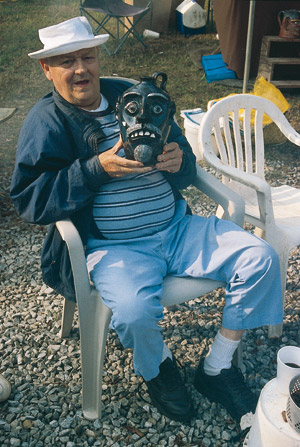 Fig. 11. Bobby Ferguson with face jug he made, Gillsville, Georgia, 2004. A descendant of Edgefield-trained Charles H. Ferguson, he died in 2005, but his widow, Mary, son, Stanley, and Stanley’s daughter, Jamie Beth, carry on the tradition. Photo by the author.
Fig. 11. Bobby Ferguson with face jug he made, Gillsville, Georgia, 2004. A descendant of Edgefield-trained Charles H. Ferguson, he died in 2005, but his widow, Mary, son, Stanley, and Stanley’s daughter, Jamie Beth, carry on the tradition. Photo by the author.
Charles P. Ferguson married Catherine Hewell, of another Barrow County pottery family that migrated to Gillsville; her brother, William J. Hewell, probably learned about face jugs from his Ferguson in-laws and was the first potter of the Hewell family to make them. The Hewells, like the Fergusons, are in their seventh generation as potters and carry on a handcrafting tradition rooted in the mid-nineteenth century. Alkaline-glazed stoneware is a big part of their production, including face jugs and Thomas Chandler-style slip-decorated jars and jugs (Burrison 2010, 36–41, 103–26). It is at Gillsville that the old Edgefield District tradition lives on, contributing to north Georgia’s reputation as one of the last places in the United States where folk pottery is still being made.
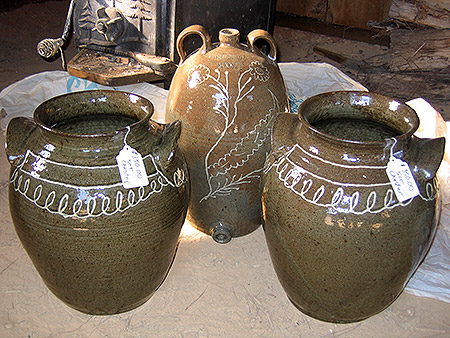 Fig. 12. Stoneware with Thomas Chandler-style slip-decoration by Chester Hewell, Gillsville, Georgia, 2008. The Hewells are aware of their connection to the Edgefield tradition through intermarriage with the Fergusons. Photo by the author.
Fig. 12. Stoneware with Thomas Chandler-style slip-decoration by Chester Hewell, Gillsville, Georgia, 2008. The Hewells are aware of their connection to the Edgefield tradition through intermarriage with the Fergusons. Photo by the author.
Works Cited
Baldwin, Cinda K. Great and Noble Jar: Traditional Stoneware of South Carolina. Athens: University of Georgia Press, 1993.
Brackner, Joey. Alabama Folk Pottery. Tuscaloosa: University of Alabama Press, 2006.
Bresler, Joel. “Follow the Drinking Gourd: A Cultural History.” <http://www.followthedrinkinggourd.org>.
Brown, Michael K. The Wilson Potters: An African-American Enterprise in 19th-Century Texas. Houston: Museum of Fine Arts, Bayou Bend Collection, 2002.
Burrison, John A. Brothers in Clay: The Story of Georgia Folk Pottery. Athens: University of Georgia Press, 1983.
——. “Fluid Vessel: Journey of the Jug.” Ceramics in America 6 (2006): 93–121.
——. From Mud to Jug: The Folk Potters and Pottery of Northeast Georgia. Athens: University of Georgia Press, 2010.
——. Roots of a Region: Southern Folk Culture. Jackson: University Press of Mississippi, 2007.
Burton, Orville Vernon. In My Father’s House Are Many Mansions: Family and Community in Edgefield, South Carolina. Chapel Hill: University of North Carolina Press, 1985.
Douglass, Frederick. “What to the Slave Is the Fourth of July?” <http://teachingamericanhistory.org/library/index.asp?document=162>.
Goldberg, Arthur F., and James P. Witkowski. “Beneath His Magic Touch: The Dated Vessels of the African-American Slave Potter Dave.” Ceramics in America 6 (2006): 58–92.
Hewitt, Mark, and Nancy Sweezy. The Potter’s Eye: Art and Tradition in North Carolina Pottery. Chapel Hill: University of North Carolina Press, 2005.
Horne, Catherine Wilson, ed. Crossroads of Clay: The Southern Alkaline-Glazed Stoneware Tradition. Columbia: McKissick Museum, University of South Carolina, 1990.
Koverman, Jill Beute, ed. I Made This Jar: The Life and Works of the Enslaved African-American Potter, Dave. Columbia: McKissick Museum, University of South Carolina, 1998.
——. Making Faces: Southern Face Vessels 1840–1990. Columbia: McKissick Museum, University of South Carolina, 2001.
Malone, James M., Georgeanna H. Greer, and Helen Simons. Kirbee Kiln: A Mid-19th-Century Texas Stoneware Pottery. Austin: Texas Historical Commission, Office of the State Archeologist Report 31, 1979.
Newell, Mark M., and Peter Lenzo. “Making Faces: Archaeological Evidence of African-American Face Jug Production.” Ceramics in America 6 (2006): 122–38.
Todd, Leonard. Carolina Clay: The Life and Legend of the Slave Potter Dave. New York: W. W. Norton, 2008.
Vlach, John Michael. The Afro-American Tradition in Decorative Arts. Athens: University of Georgia Press, 1990.
Notes
1 Stoneware, a tough ceramic product as hard as stone, is made of fine–grained, relatively pure, high–firing (2300° F.) clay.2 Josiah Wedgwood was the eighteenth–century “father” of Staffordshire, England’s pottery industry; Bernard Palissy was a decorative ceramics genius in sixteenth–century France; and Manises is a town in Valencia, Spain, famed for its lusterware production beginning in the fourteenth century.
3 Samuel Landrum’s grandfather, John, was a Scotsman who immigrated to Virginia in 1688 (Baldwin 1993, 30).
4 For salt–glazed stoneware (developed in Germany in about 1400 and still being made there in the Westerwald district), common salt is thrown in the kiln at the height of firing to create a coating of clear glass over the gray or tan clay. Salt glaze sometimes was used in the Deep South along with other stoneware glazes, including the alkaline glazes developed in Edgefield.
5 Potters of the Meaders family at Mossy Creek, Georgia, were quoted in the 1930s as referring to their ash glaze as “Shanghai” glaze, suggesting a folk memory of its Asian inspiration.
6 Earthenware is made from coarse–grained clay that has a higher iron content and lower firing temperature than stoneware clay, resulting in a softer and more porous product. In the Euro–American tradition it was coated with a lead–based glaze, making redware (as it is often referred to by American ceramics historians) a health hazard and paving the way for the widespread production of nontoxic stoneware, beginning in the eighteenth century.
7 A chronological listing of Dave’s inscriptions appears in Todd (2008, 232–51); a shorter list is in Goldberg and Witkowski (2006, 87–88). As reproduced here, the poems follow the original spelling, punctuation, and idiosyncratic marks.
8 The song was first published in 1928, and its authenticity as a slave song has since been questioned (Bresler, “Follow the Drinking Gourd: A Cultural History”).
Author
Suggested Citation

This work is licensed under a Creative Commons Attribution-ShareAlike 3.0 Unported License.


